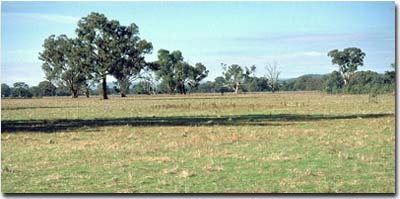Black Dog Fine Sandy Loam
Black Dog Fine Sandy Loam is marked by a thick, strongly bleached subsurface (A2) horizon and a yellow mottled friable clay in the subsoil (B) horizon. Large soft ferruginous inclusions are an irregular but striking feature of the subsoil. It is the main soil type on the lower terrace of the southern part of the station. The features separating it from Lilliput Loam, another soil type with a strongly bleached A2 horizon, are set out under Lilliput Loam - Relationship to Other Soil Types.
 Typical landscape where Black Dog Fine Sandy Loam occurs. |
Typical Profile
| Surface | ||
| A1 | 0-12 cm | Grey-brown to dark grey-brown fine sandy loam; 10 to 17 cm thick; usually separated by a clear boundary from: |
| A2 | 12-45 cm | Light grey strongly bleached (very light grey when dry) fine sandy loam; brittle and slightly compacted; irregularly vesicular; light buckshot is often present in the lower part of the horizon; 27 to 45 cm thick; usually a distinct boundary to: |
| Subsoil | ||
| B21 | 45-85 cm | "Yellow" mottled friable clay, or clay-loam passing to clay (the main colours are various shades of yellow and brown, or brownish red common associate colours); fabric or labile when moist; some times with large soft ferruginous concretions; 35 to 50 cm thick; sharply separated from: |
| B22 | 85-120 cm | Moderately or diffusely mottled clay, with grey and dull brown and reddish brown frequent colours; labile when moist, and the clay is noticeably more intractable than the horizon above; with black inclusions (or soft black concretions) near the horizon boundary; small amounts of (fine) calcium carbonate irregularly present. |
Soil Pit NE42 is a soil profile described within the Black Dog Fine Sandy Loam mapping unit. These soils are typically classified as Grey SODOSOLS using the Australian Soil Classification.
Variations
Organic matter may give the A1 horizon a loam texture. Soils with a grey mottle, instead of the yellow subsoil described above, have been included in the type. Subsoil textures, ranging from sandy clay loam to light clay, tend to be lighter than in the normal type. These soils always contain soft ferruginous concretions in the lower part of the A2 and throughout the B horizons. This variant comprises about 10% of the soil type as mapped.


